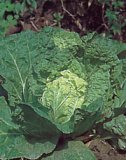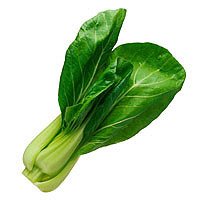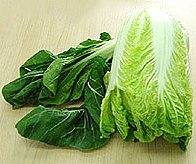Chinese Cabbage
http://www.100md.com
《e Natural Health Center》
 |
 |
 |
 |
Vegetables
Chinese Cabbage
Latin:
Brassica chinensis
Origin:
Chinese cabbage refers to either one of two widely cultivated members of the Mustard (Brassicaceae) family: Brassica chinensis (L), or bok choy; and Brassica pekinensis ((Lour.) Rupr.), or wong nga pak.
, 百拇医药
Brassica chinensis (L.), or Brassica rapa chinensis (L.) Hanelt., also called Chinese mustard, or bok choy in Chinese, has glossy blue-green leaves and thick, crisp, long white stalks in a loose head. Its yellow-flowering centre is especially prized. Brassica chinensis has a mild flavor, and is a familiar vegetable in Chinese restaurants, where it appears in won ton soup and many stir-fried dishes.
Brassica chinensis grows to about 0.9 m high. It is in flower from May to August. The flowers are hermaphrodite (have both male and female organs) and are pollinated by bees. The plant can grow in semi-shade (light woodland) or no shade. It requires moist soil.
, 百拇医药
The varieties of Brassica chinensis include baby bok choy, which is smaller and more tender than mature bok choy. Shanghai pak choi is similar to bok choy but has pale green stalks with leaves that are just slightly darker than the stalk.
Brassica chinensis is available year-round. Because it is a cold-weather vegetable, availability is good during the winter.
Brassica pekinensis ((Lour.) Rupr.), also called celery cabbage, napa, and Peking cabbage, or wong nga pak in Chinese, forms a tight head of crinkled light green leaves. It is possibly a cross between Brassica campestris rapa (the turnip) and Brassica chinensis (bok choy). One type, Michihli, or Tientsin, forms slender cylindrical heads about 45 cm tall. It has long been grown in the United States as a salad vegetable. Napa is similar, but its heads are shorter and thicker, 30 cm tall. It has a milder flavor and aroma than Brassica chinensis.
, http://www.100md.com
Brassica pekinensis grows to about 0.5 m. The flowers are hermaphrodite (have both male and female organs) and are pollinated by bees. The plant can grow in semi-shade (light woodland) or no shade. It requires moist soil.
Brassica pekinensis is a specific type of cabbage, and only one variety is known. It is available all year long.
Native to China, both species are now naturalized in many parts of the world.
, http://www.100md.com
All Chinese cabbages are delicate and crisp, qualities that enable them to combine with a wide variety of foods. Kimchi, the universal Korean pickle, is often made with Chinese cabbage.
Properties:
Sweet in flavor, mild and slightly cold in nature, it is related to the lung, stomach and bladder channels.
It has crinkly, cream-colored leaves with pale green tips, and a milder flavor and aroma than common cabbage.
, 百拇医药
Functions:
Clears heat, calms the mind, quenches thirst, promotes urination, detoxifies.
Applications:
Chinese cabbage is used to treat thirst due to heat in lungs and stomach, coughing and constipation due to lung heat; little urination due to heat in gall-bladder; relieves alcoholic toxics; or used externally for carbuncles.
, http://www.100md.com Dosage and Administration:
To prepare Brassica chinensis, chop off enough of the base of the plant before washing so that stalks can be cleaned individually. Rinse stalks and leaves under running water, using a vegetable brush if they are especially dirty at the base of the stalk.
Brassica chinensis stalks can be consumed raw with dip, or chopped and used in salads. Brassica chinensis has a high water content and becomes limp very quickly upon cooking. It should be cooked very quickly over high temperature so that the leaves become tender and the stalks stay crisp. In Chinese stir-fried dishes and soups, Brassica chinensis, or bok choy, is added toward the end of the cooking process. Since the leaves cook much more quickly than the stalks, it's a good idea to add the stalks first and then the leaves about a minute later. Cut the stalks into 1.25 cm pieces before cooking.
, http://www.100md.com
To boil: Cook stems in salted water for four minutes and leaves for two to three minutes.
To steam: Allow pieces to steam for about six minutes, or until tender-crisp.
To saute: Stir-fry the stalks over high heat for about six minutes and the leaves for about three minutes, until stalks are tender-crisp and leaves are just wilted.
Bok choy goes well with the flavors of soy sauce, hot peppers, and toasted sesame oil.
, http://www.100md.com
For Brassica chinensis, or bok choy, look for ones with firm stalks and leaves. Avoid yellowing or wilted leaves. Store in an unsealed plastic bag. Brassica chinensis generally keeps well and will stay fresh for more than a week, but should be used in four to five days for best flavor.
To prepare Brassica pekinensis, remove the stem, separate the leaves, and wash well. Slice the leaves into strips about 2.5 to 4.0 cm thick and stir-fry with carrots, red peppers, mushrooms, and tofu or chicken.
, http://www.100md.com
Brassica pekinensis can be found in the produce section of most health food stores, specialty markets, and some supermarkets. Choose firm, tightly packed heads that have crisp, green-tipped leaves. Refrigerate it, tightly wrapped, for up to three days.
Cautions on Use:
Reference Materials:
Toxic or Side Effects:
, 百拇医药
Modern Researches:
Every 85 g of brassica chinensis, or bok choy, contains 14 calories, 1 g protein, 2.73 g carbohydrate, 0.18 g fat and 0.84 g fiber; there are also ash, calcium, phosphorus, iron, sodium, potassium, vitamins A and C, thiamine, riboflavin, niacin, etc.
The leaf of brassica chinensis is antiarthritic, antiscorbutic (counteracting scurvy) and resolvent.
Every 85 g of boiled Brassica pekinensis contains 10 calories, 1.3 g protein, 1.5 g carbohydrate, 0.1 g fat, and 1.4 g fiber; there are also ash, calcium, phosphorus, iron, etc.
The leaves of Brassica pekinensis are depurative (purifying the blood)., 百拇医药